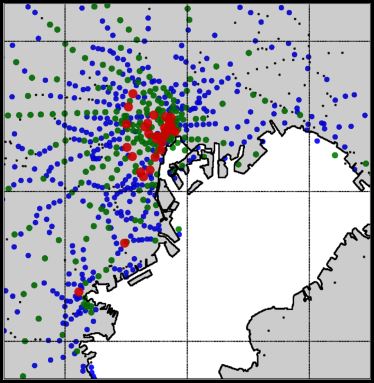Counteracting disease spread over city commuter networks
To fight the outbreak and spread of disease across public transport networks, city health officials should target the largest station, as preventative measures there are likely to be substantially more effective than at any of the smaller stations, IIASA work has shown. For the study researchers developed a new method for identifying the stations with the highest benefits in fighting disease spread, and tested it on the Tokyo public transport system.
Public transport networks in large cities are the perfect way for a disease to spread. The confined spaces, the high numbers of people passing through—especially during the daily commute—mean that a virulent disease could make its way across the city in even a few hours.
To face this challenge, health officials need to design countermeasures that fight disease spread while remaining cost effective. A promising strategy, research shows, is to target the hubs of the transport network, such as particularly busy stations. A study by the IIASA Evolution and Ecology Program uses innovative network analysis to show how such hubs can best be identified.
Using Tokyo as a test case, the team developed a new type of “network centrality measure,” which quantifies the relative importance—in terms of disease spread—of each location in the network.
The results show that the impact of taking countermeasures at the largest station is more than 1,000 times more effective in stopping disease spread than at the second largest station, even though the number of people passing through is only around 1.5 times larger. On top of this, the effect of countermeasures at other stations is strongly dependent on the number of commuters at the largest station.
Providing vital information to city health officials around the world, this study is among the first to show that only the largest hubs play such an extraordinary role.
The researchers also found the stations that are important for preventing an outbreak of infection in the population are not necessarily the same as those that are important for reducing the number of people infected.
This means that health officials must design different strategies for before a disease is identified and after it has begun to spread.
Commuter network of the Tokyo Metropolitan Area. Each circle corresponds to a station of the public transportation network, with colors indicating daily commuter numbers (black: < 1,000; blue: < 10,000; green: < 100,000; red: > 100,000). The study helps select stations offering the highest returns on disease-fighting investments.
References
[1] Yashima K & Sasaki A (2016). Spotting epidemic keystones by R0 sensitivity analysis: high-risk stations in the Tokyo Metropolitan Area. PLOS One 11: e0162406.
Collaborators
- Department of Evolutionary Studies of Biosystems, Graduate University for Advanced Studies, Japan
- Meiji Institute for Advanced Study of Mathematical Sciences, Meiji University, Japan

